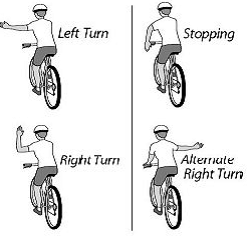Bicycles have the right to use Florida roads. Bicyclists must ride defensively and be prepared to yield at all times.
Being a smaller vehicle on a road full of larger, faster vehicles can be quite intimidating. Urban sprawl has made it much more difficult to operate slower moving vehicles in this fast moving culture. Cyclists must learn techniques and practice skills to operate safely and confidently on the roadways. Safety measures such as selecting the appropriate size bicycle, obtaining proper safety equipment, learning and adhering to all laws of the road and properly maintaining all of your cycling equipment should be top priorities before venturing out for a ride.
The responsibility of safely navigating on the roadways falls on every cyclist. Motorists must know what your intentions are concerning turning maneuvers and stopping. Cyclists should seek out and gain knowledge on proper hand signals, practice them and utilize them consistently.

Safe Riding Tips.
See and be seen. Whether daytime, dawn, dusk, night or foul weather, you need to be seen by others. Wear bright clothes (neon or fluorescent) when riding day or night. Wear something reflective such as a light, tape or markings. Always attempt to make eye contact with drivers. Assume they don’t see you until you are sure they do.
Be predictable. Ride in a straight line, not in and out of cars. Signal your moves to others prior to initiating the maneuver.
Control your bicycle. Always ride with at least one hand on the handlebars. Carry books and other items in a bicycle carrier or backpack.
Stay alert and avoid road hazards. Use your eyes and ears. You need your ears to hear traffic and avoid dangerous situations, don’t wear a headset when you ride. Be on the lookout for hazards such as potholes, broken glass, gravel, puddles, leaves, and dogs. All these hazards can cause a crash. If you are riding with friends and you are in the lead, yell out and point to the hazard to alert the riders behind you.
Go with the traffic flow. Ride on the right in the same direction as other vehicles. Go with the flow not against it.
Obey all traffic laws. A bicycle is a vehicle and you must obey all traffic signs, signals and lane markings.
Yield to traffic when appropriate. If there is no stop sign or traffic signal and you are coming out of a driveway, off of a sidewalk or from a bike path, you must slow down and look to see if the way is clear before proceeding into the roadway. This also means yielding to pedestrians who have already entered a crosswalk.
Don’t pass on the right. Motorists may not look for or see a bicycle passing on the right.
Look before turning. When turning left or right, always look behind you for a break in traffic, then signal before making the turn.
Watch for parked cars. Ride far enough out from the curb to avoid the unexpected from parked cars, like doors opening or cars pulling out.
Avoid riding at night. It is far more dangerous to ride at night than during the day because you are harder for others to see. If you have to ride at night, make sure you have a bright headlight on front of your bike and reflectors on the front and rear of your bike.
